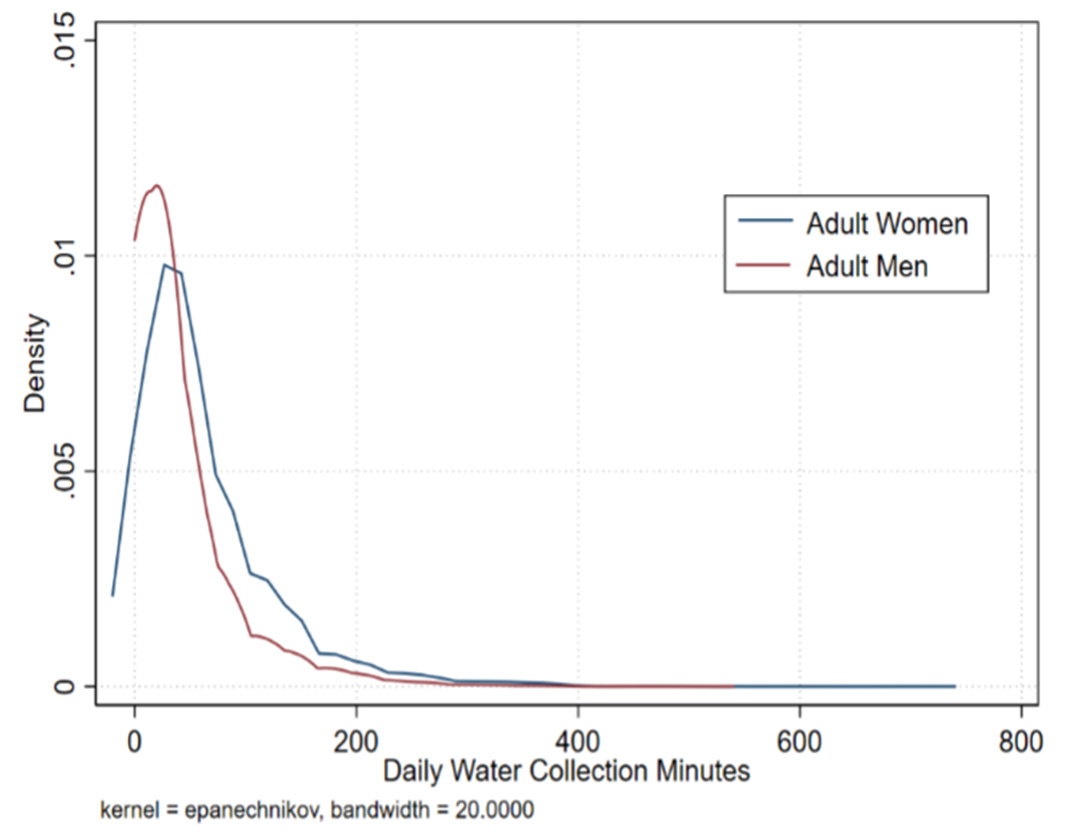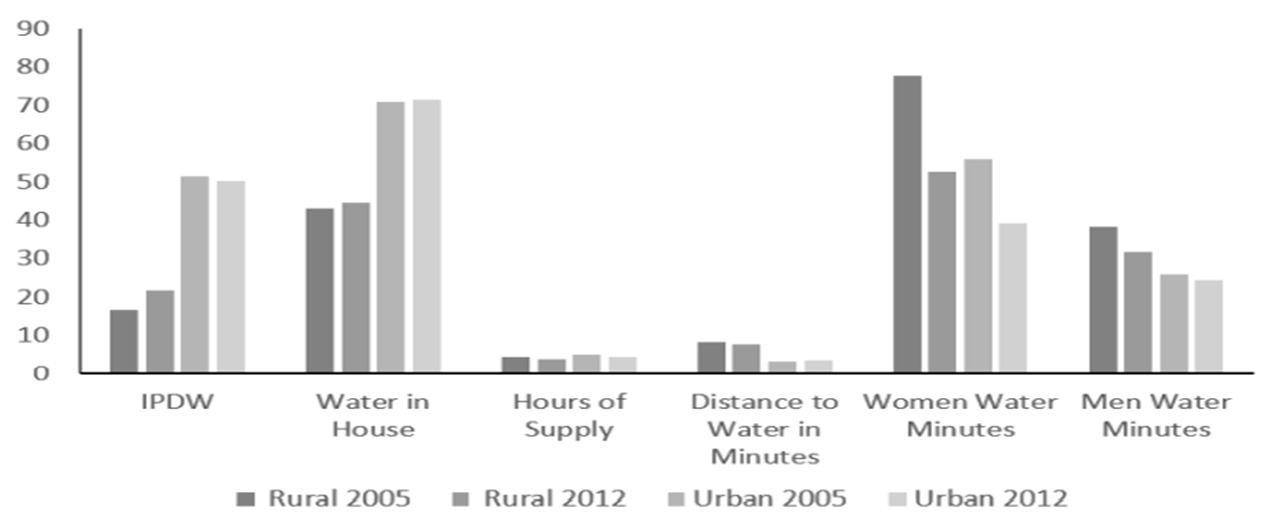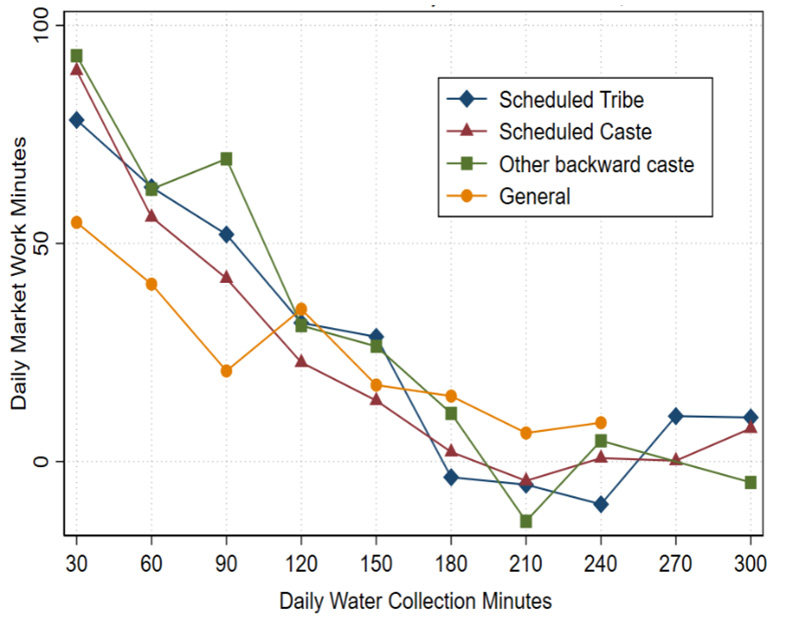In India, there is limited access to indoor piped drinking water (IPDW) in households, and this has a disproportionate impact on women as they bear the burden of fetching water. Using 2005-2012 India Human Development Survey data, this article shows that household access to IPDW can help reduce gender differences in employment, especially in rural areas and both in terms of farm and non-farm employment.
The importance of water for personal and household use in everyday life is understood most distinctly when one does not have easy access and must wait for it and/or carry it from a distance. This unproductive burden is disproportionately placed on women and children in India. While men choose – or are socially conditioned – to assume the breadwinner role, women and children, particularly girls, are often solely responsible for home production – such as fetching water and firewood, cleaning, cooking, and general running of the household (O’Reilly 2006, Fletcher et al. 2017, Jayachandran 2019). Lack of piped water implies use of more open sources of water, which poses greater health risks for the household and more illness – leading to more unpaid work for women. Given the disproportionate burden of home production on women, and the fact that Indian households have little access to indoor piped water (Coffey et al. 2014, Choudhuri and Desai 2021), in a recent study (Sedai 2021), I show that access to piped water in the household can reduce intra-household labour and health inequality.
Impact of indoor piped water on women’s time use and labour
The basic trade-offs in the context of indoor piped drinking water (IPDW) are highlighted in the standard economic theory of time allocation and labour productivity (Becker 1965). First, the lack of IPDW affects women disproportionately through an increase in the amount of time spent on the household chore of collecting water. The argument for employment is that the time saved from not having to fetch water daily, could be reallocated to the labour market (Meeks 2017). Figure 1 plots the higher burden of water collection on women in India. Figure 2 shows the correlation between time allocated to paid work and water collection for women, by caste.
Figure 1. Daily water collection (in minutes) for adult women and men

Notes: (i) The above figure shows the kernel density plot of the burden of water collection on women in India. (ii) Adult women and men include those in the ≥14 years age group.
Source: 2005-2012 India Human Development Survey (IHDS).
Figure 2. Daily water collection and market work (in minutes) for Women, by caste
Second, the lack of IPDW leads to weak personal health due to higher surface-water contamination-based illness. Third, in the absence of IPDW, families often resort to communal and less clean sources of drinking water (such as open wells, hand pumps, or other surface-level sources), and may wash their hands less often – leading to more illness in the family. Consequentially, women spend more time on unpaid care work (such as caring for diarrhoea-stricken children who do not attend school, or elders with fever, cough and other infections) and less in the labour market.
Following the above hypothesis, I first examine the state of IPDW in India. The IHDS (India Human Development Survey) 2005-2012 and ACCESS (Access to Clean Cooking Energy and Electricity Survey of States) 2015-2018 panel data show a clear lack of adequate IPDW at the household level in India. IHDS data show that, in 2005, the average access to IPDW was 16% and 51% in rural and urban areas, respectively; while in 2012, the average access was 21% and 50% in rural and urban areas, respectively. The approximate 5% increase in IPDW in India with the National Rural Drinking Water Programme is a rural phenomenon. There are disparities between and within states in India. The average access to IPDW at the district level (IHDS-surveyed districts) in both years was around 0.25% to 0.5%. Barring a few districts (mostly in cities, and the southern and western regions of India) where the average hours of IPDW supply are between six and 12 hours, most districts, regardless of state, receive water supply for about one and seven hours a day. Overall, there is a serious lack of drinking water infrastructure at the household level in India.
Who benefits from indoor piped drinking water?
I examine the effects of IPDW on employment and health outcomes at the individual, household, and village level; by gender and location. To capture the variation in access to IPDW1, I use a nationally representative panel2 of the IHDS (2005-2012)3 (Desai and Vanneman 2018). The survey also covers key gender-disaggregated labour and non-labour market characteristics (that is, unpaid care work at home), employment data such as wage salary, farm, non-farm employment, annual earnings, workdays, and self-reported health, incidence of illness, such as diarrhoea, and water collection minutes, among others at the individual level. I use a time balanced sample4 of 71,623 women and 78,751 men from each round of the IHDS survey for the analysis.
Figure 3. Access to water and water collection during 2005-2012, by gender

Notes: (i) IPDW and ‘water in house’ are in percentage terms. (ii) Hours of water supply, and water collection minutes are daily averages conditional on at least some time spent on water collection.
I approach the empirical analysis in the following manner: First, I examine the effect of IPDW on employment outcomes by collapsing individual-level data to the village level and controlling for village-level water infrastructure placement through exogenous village-level characteristics across time5. Secondly, I use the temporal variation in average access to IPDW in all other villages or Primary Sampling Units in a particular district of a state as an instrumental variable6 to find causal estimates with the Local Average Treatment Effects7. The instrument positively affects the likelihood of access to IPDW for a household in a district, but does not directly affect the outcomes of employment and health at the individual level, conditional on other controls. Higher average access in other villages positively affects the access in a given village through the relative ease of setting up water infrastructure once it is available in nearby areas, and through awareness of the benefits of piped water. Given the low average of access to IPDW, I anticipate that other village-level access will not have any effect on the outcome of an individual in a given village once we exclude the village of the individual in question. I do anticipate that household’s own community-level IPDW will have an impact on individual labour force participation, hence excluding one’s own village from the instrument is key to the ‘exclusion restriction’.
Table 1. Access to IPDW in India
|
Observations |
Mean |
Standard deviation |
Mean |
Standard deviation |
T test | |
|
IHDS |
2005 |
2012 |
||||
|
IPDW |
40,018 |
0.236 |
0.442 |
0.302 |
0.459 |
*** |
|
ACCESS |
2015 |
2018 |
||||
|
IPDW |
8,563 |
0.057 |
0.232 |
0.066 |
0.248 |
** |
Source: Author calculations based on 2005-2012 IHDS and 2015-2018 ACCESS survey.
Notes: (i) The ACCESS survey covers rural areas in six relatively poorer states in India: Madhya Pradesh, Uttar Pradesh, Odisha, Bihar, Jharkhand, and West Bengal. (ii) The t-test shows mean difference in access to IPDW by the year of survey, 2015 and 2018. ***, **, and * indicate significance at the 10%, 5%, and 1% levels of confidence respectively. (iii) Standard deviation is a measure that is used to quantify the amount of variation or dispersion of a set of values from the average of that set.
IPDW and employment
I find that having access to IPDW increases women's likelihood of any employment (any form of paid work for a period of 30 days or more) by 11.3 percentage points (pp), and men's likelihood of employment by 11.9 pp for the overall sample. These effects vary across rural and urban areas. In rural areas, access to IPDW leads to a 19.5 pp increase in the likelihood of employment for women, significantly higher than the 12.1 pp increase for men. In contrast, in urban areas, the positive effect of IPDW on employment is visible only for men (17.4 pp), while women experience no effects of IPDW on their employment. In terms of wage/salary8 employment, I find that access to IPDW increases women's likelihood of employment by 12.1 pp and that of men by 11 pp for the overall sample. In rural areas, this effect is 16 pp for women and 8.9 pp for men. This shows that the employment gains for women from IPDW are not limited to farm employment or self-employment; these are visible in wage salary employment as well. However, as observed with ‘any form of employment’, there is no effect of IPDW on women's wage/salary employment in urban areas. However, there is a positive and significant effect of IPDW on men’s employment in urban areas (13.6 pp increase in wage/salary employment). The gains in wage employment in rural areas are critical to women's economic and social autonomy given the high degree of disguised unemployment (surplus labour), especially for women in the agricultural sector in India (Mazumdar and Sarkar 2020).
My analysis shows that access to IPDW increases annual earnings by 13.8%, for both men and women combined. The effect is stronger for women – 17.5% as compared to 11.2% for men. As with the likelihood of employment, the increase in earnings for women is observed only in rural areas. Men, on the other hand, have increased earnings both in rural and urban areas. The positive effect of IPDW on women's earnings – and it being higher for women than men in rural areas – I argue, could be due to a combination of time, health, and productivity effects which could ease the burden of household water collection and availability of clean water for women. IPDW increases annual workdays for women by 28 days in rural areas, while there is no significant effect in urban areas. For men, there are no significant effects in rural and urban areas. Overall, the employment implications of IPDW are for rural women, but for both rural and urban men, indicating that the impediment to women’s employment in urban areas goes beyond the necessities of basic infrastructures.
IPDW, health, and education
I also find that access to IPDW leads to a 33.7 pp improvement in women's self-reported health9 in rural areas, and 50.6 pp improvement in self-reported health for poor women. The analysis shows that having access to IPDW reduces the likelihood of diarrhoea by 1.5 pp for the overall sample. I find a stronger effect of IPDW on diarrhoea in urban areas, a 2.2 pp reduction. This is expected due to a higher surface-level contamination of household water supply in urban areas. For the sample, access to IPDW leads to 1.48 less days of absence from school in a month. For girls, this effect is 1.55 less days of school absence in a month. The effects are also more pronounced for rural girls as compared to urban girls, 2.44 and 1.39 less days of school absence in the past month, respectively.
Concluding remarks
I find IPDW to be critical in reducing gender differences in employment, with women benefitting significantly from access to pipe water in the house in terms of employment opportunities – especially in rural areas – both on and off-farm employment. In the context of the rapid fall in women's labour force participation rate in India, 30% in 1995 to 20% in 2012 10, increasing access to IPDW among rural households, from a supply standpoint, could play a crucial role in reducing gender differences in employment opportunities in rural India. IPDW could also be important, in terms of infrastructure, to improve household health, which could in turn reduce women’s unpaid work in the household, leading to more time being available for paid labour market activities. My results show that in the case of a lack of piped water, women's economic freedom is lower than what it could be. In this light, availability of basic infrastructure such as water, electricity, toilets, and gas among other basic infrastructure could be critical to the socioeconomic empowerment for women in India.
I4I is on Telegram. Please click here (@Ideas4India) to subscribe to our channel for quick updates on our content
Notes:
- Our treatment variable ‘IPDW’ is derived from the survey item, “Does your household have access to indoor pipe drinking water?” Yes is 1 and No is 0.
- Panel data documents the same unit of observations (firms in this case) repeatedly across time.
- The IHDS covers wide-ranging topics at the household, individual, village and school level on demographic, health, education, and socioeconomic characteristics.
- Time-balanced” sample implies we exclude households that do not appear in both the survey waves.
- The fixed effects set up here controls for any village-specific effects over time, and the coefficients of the regression are considered to be conditionally exogenous, once we assume that the selection in or out of IPDW is at the individual or household level (Koolwal and van deWalle 2013, Choudhuri and Desai 2021).
- Instrumental variables are used in empirical analysis to address endogeneity concerns. An instrument is an additional factor that allows us to see the true causal relationship between the explanatory factor and the outcome of interest. It is correlated with the explanatory factor but does not directly affect the outcome of interest.
- The same ‘leave out’ community strategy has been used to identify the effect of in-yard water access on child and maternal health in rural India and China (Lamichhane and Mangyo 2011, Vanaja 2020).
- Wage/salary variable is derived from the IHDS individual survey questionnaire which asks: “Now, besides work on the household farm or in any of the household's businesses, what work did [NAME] DO LAST YEAR for payment in cash or kind”.
- I assign ‘good’, ‘very good’ and ‘OK’ health responses as being equal to 1, and ‘poor’ and ‘very poor’ health as being equal to 0.
- Author’s calculations from the World Bank’s World DevelopmentIndicators, comparing the averages of labour force participation for women, age 14-59, from 1995-2005 to 2005-2014.
Further Reading
- Andrews, Isaiah, James H Stock and Liyang Sun (2019), “Weak instruments in instrumental variables regression: Theory and practice”, Annual Review of Economics, 11: 727-753.
- Becker, Gary S (1965), “A theory of the allocation of time”, The Economic Journal, 75(299): 493-517.
- Coffey, Diane, Ashish Gupta, Payal Hathi, Nidhi Khurana, Nikhil Srivastav, Sangita Vyas and Dean Spears (2014), “Open defecation: evidence from a new survey in rural north India”, Economic and Political Weekly, 49(38): 43-55.
- Cronin, Aidan A and Nisha Thompson (2014), “Data and monitoring in the Indian rural water and sanitation sector: a review of current status and proposed ways forward”, Journal of Water, Sanitation and Hygiene for Development, 4(4): 590-603.
- Choudhuri, Pallavi and Sonalde Desai (2021), “Lack of access to clean fuel and piped water and children’s educational outcomes in rural India”, World Development, 145: 105535.
- Desai, S, R Vanneman and National Council of Applied Economic Research (2018), ‘India Human Development Survey-II (IHDS-II), 2011-12’, Inter-university Consortium for Political and Social Research.
- Fletcher, Erin, Rohini Pande and Charity Troyer Moore (2017), ‘Women and work in India: Descriptive evidence and a review of potential policies’, HKS Faculty Research Working Paper Series RWP18-004.
- Jayachandran, S (2021), “‘Social norms as a barrier to women's employment in developing countries”, IMF Economic Review, 69: 576-595.
- Koolwal, Gayatri and Dominique Van de Walle (2013), “Access to water, women's work, and child outcomes”, Economic Development and Cultural Change, 61(2): 369-405.
- Lamichhane, Dirga Kumar and Eiji Mangyo (2011), “Water accessibility and child health: Use of the leave-out strategy of instruments”, Journal of Health Economics, 30(5): 1000-1010.
- Mani, S, T Shahidi, S Patnaik, A Jain, S Tripathi, K Ganesan, M Aklin, J Urpelainen, N Chindarkar, Council on Energy, Environment and Water, Initiative for Sustainable Energy Policy and National University of Singapore (2018), ‘Access to Clean Cooking Energy and Electricity: Survey of States in India 2018 (ACCESS 2018)’.
- Mazumdar, D and S Sarkar (2020), ‘Agricultural productivity, farm employment and rural poverty: The problem of labor absorption in agriculture’, in D Mazumdar (ed.), Globalization, Labor Markets and Inequality in India.
- Meeks, Robyn C (2017), “Water works the economic impact of water infrastructure”, Journal of Human Resources, 52(4): 1119-1153.
- National Statistical Office (2020), ‘Time Use in India-2019’, Ministry of Statistics and Programme Implementation Report.
- O'Reilly, Kathleen (2006), ““Traditional" women, “modern" water: Linking gender and commodification in Rajasthan, India”, Geoforum, 37(6): 958-972.
- Vanaja, S (2020), ‘Essays on the time use and behavioral patterns of women's access to household water in rural India’, Tata-Cornell Institute
- Wescoat Jr, James L, Sarah Fletcher and Marianna Novellino (2016), “National rural drinking water monitoring: progress and challenges with India’s IMIS database”, Water Policy, 18(4): 1015-1032. Available here.




 17 January, 2022
17 January, 2022 





Comments will be held for moderation. Your contact information will not be made public.